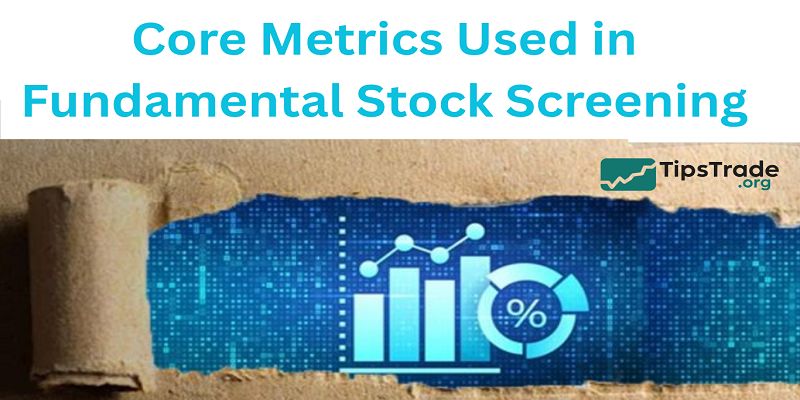Fundamental Analysis Stock Screening is a method used to filter and identify stocks that meet specific fundamental criteria, helping investors find undervalued or high-potential investment opportunities. This process involves examining key financial metrics such as earnings, revenue growth, debt levels, and profitability to build a shortlist of stocks that fit an investor’s strategy. Visit tipstrade.org and check out the article below for further information
What Is Fundamental Analysis Stock Screening?

Definition and Purpose
- Fundamental analysis stock screening refers to the process of filtering thousands of stocks based on measurable financial data—such as P/E ratio, revenue growth, or debt levels—to find the best investment opportunities.
- The goal is to narrow down the universe of stocks to a manageable list that fits your strategy.
- Unlike technical analysis, which focuses on price charts and momentum, fundamental screening helps investors evaluate a company’s intrinsic value and long-term potential.
- According to Morningstar, investors who use fundamental filters can outperform the market by avoiding overvalued or financially weak companies.
Why Screening Helps Investors Avoid “Bad Stocks”
- Many beginners buy stocks based on hype or media coverage, but screening helps remove emotion from the decision-making process.
- By focusing on financial strength and valuation, investors can spot red flags early—such as declining margins or unsustainable debt.
- For example, a company with consistent revenue growth but shrinking cash flow might be masking operational inefficiencies.
- A solid screener setup highlights these weaknesses before they become costly mistakes.
How Stock Screeners Work (Manual vs Automated Tools)
A stock screener uses a database of company financials and allows users to filter by specific criteria.
- Manual screening involves reviewing metrics directly from annual reports or financial sites.
- Automated screening uses tools like Finviz, Yahoo Finance, or TradingView to instantly display stocks meeting your filters.
- Professional investors often combine both—using automated tools for data gathering, and manual review for qualitative insights like management quality or industry trends.
Core Metrics Used in Fundamental Stock Screening

A good screener includes key financial ratios across valuation, profitability, growth, and balance sheet strength. Let’s break them down.
Valuation Metrics
Valuation metrics determine whether a stock is cheap or expensive relative to its earnings and assets.
- P/E (Price-to-Earnings): Lower than industry average may signal undervaluation.
- PEG Ratio: Adjusts P/E for growth; below 1 is often ideal.
- P/B (Price-to-Book): Useful for asset-heavy sectors like banks.
- EV/EBITDA: Offers a cleaner view than P/E by including debt impact.
Example: Warren Buffett prefers companies with consistent earnings and a P/E lower than their long-term growth rate.
Profitability Metrics
Profitability shows how efficiently a company turns revenue into profit.
- ROE (Return on Equity) > 15% = strong management efficiency.
- ROA (Return on Assets) = profitability per dollar of assets.
- Gross & Net Margins: Reflect pricing power and cost control.
High ROE combined with low debt often indicates durable competitive advantage or “economic moat.”
Growth Metrics
Growth screening focuses on future potential.
- Revenue Growth (5-Year CAGR)
- EPS Growth (Earnings Per Share)
- Free Cash Flow Growth
Growth-oriented investors like Peter Lynch used these to identify “multi-bagger” stocks early.
Financial Health Metrics
Strong balance sheets protect companies in downturns.
- Debt-to-Equity Ratio < 0.5 is considered safe.
- Current Ratio > 1.5 shows good liquidity.
- Interest Coverage Ratio > 5 = manageable debt costs.
These help identify financially resilient firms that can survive economic shocks.
Dividend Metrics
Dividend investors focus on income stability:
- Dividend Yield (preferably 2–5%)
- Payout Ratio < 70%
- Dividend Growth Rate over 5 years
Reliable dividend payers like Johnson & Johnson or Coca-Cola maintain consistent payouts across cycles.
Step-by-Step: How to Screen Stocks Using Fundamental Analysis
Step 1 – Filter by Industry and Market Cap
- Start by narrowing your focus. For beginners, mid-to-large-cap companies offer stability.
- Choose industries you understand—like banking, technology, or consumer goods.
Step 2 – Apply Valuation Filters
- Use metrics like P/E < 20 or EV/EBITDA < 10 to eliminate overpriced stocks.
- Compare these ratios with the sector average on platforms such as Finviz or Morningstar.
Step 3 – Choose Profitability and Quality Metrics
- Add filters for ROE > 15% or Net Margin > 10%.
- This ensures you’re selecting companies with solid profitability and efficient management.
Step 4 – Check Debt and Financial Stability
- Screen for Debt/Equity < 0.5 or Interest Coverage > 5.
- High debt can destroy shareholder value, especially when interest rates rise.
Step 5 – Evaluate Growth Potential
- Add Revenue Growth > 10% (5Y CAGR) or EPS Growth > 15% for growth-focused investors.
- Use Finviz or SimplyWallSt for visualization.
Step 6 – Compare Against Peers
- Ranking your shortlisted companies against competitors highlights relative value.
- For instance, if Microsoft’s ROE and profit margin outperform Apple’s, it might offer a better entry at the right valuation.
Step 7 – Final Shortlist for Deeper Research
- After applying filters, analyze qualitative factors—management, innovation, and industry trends—before making a buy decision.
Best Screeners for Fundamental Analysis

Free Screeners
- Yahoo Finance: Simple filters and data export.
- Finviz: Visual heatmaps and advanced filters.
- TradingView: Real-time financials and chart integration.
- MarketWatch: Great for quick fundamental overviews.
Paid Screeners
- Morningstar Premium – deep valuation models.
- Seeking Alpha – crowd-sourced insights + data.
- SimplyWallSt – visual “snowflake” model of valuation and health.
- Gurufocus – used by value investors for decades.
Custom Screening on TradingView
You can create a custom screener using financial syntax:(pe_ratio < 20) and (roe > 15) and (debt_to_equity < 0.5)
Common Mistakes When Screening Stocks

- Ignoring Industry Context: A “cheap” tech stock may still be overvalued compared to peers.
- Overreliance on Ratios: No single metric tells the full story. Combine multiple indicators.
- Short-Term Data: Always evaluate 5-year averages for consistency.
- Neglecting Qualitative Factors: Leadership quality, innovation, and brand power matter.
Avoiding these mistakes ensures your screen delivers genuine long-term winners.
Fundamental Screening vs Technical Screeners
| Feature | Fundamental Analysis | Technical Analysis |
| Focus | Financial health & value | Price trends & momentum |
| Time horizon | Long-term (months/years) | Short-term (days/weeks) |
| Key Tools | P/E, ROE, Cash Flow | RSI, MACD, Moving Averages |
| Ideal for | Value & growth investors | Traders |
The best investors combine both. For example, use fundamental filters to pick strong stocks, then apply technical charts to identify the right buying time.
Choose Your Investor Path
Beginner Template (Safe Blue-Chip Screen)
- Market Cap > $10B
- ROE > 10%
- Debt/Equity < 0.5
- Dividend Yield > 2%
Value Investor Template
- P/E < 15
- P/B < 1.5
- Strong Free Cash Flow
Growth Investor Template
- EPS Growth (5Y) > 20%
- Revenue CAGR > 15%
- ROE > 15%
Dividend Investor Template
- Dividend Yield > 3%
- Payout Ratio < 70%
Conclusion
Fundamental Analysis Stock Screening is essential for effective stock market investing as it saves time and enhances decision-making by narrowing down the vast universe of stocks to those that truly meet an investor’s financial standards. This approach reduces emotional bias by relying on quantitative data and also helps uncover hidden gems that may be overlooked by others. Ultimately, stock screening based on fundamental analysis empowers investors to build a disciplined portfolio with stocks that align with their long-term investment goals.

